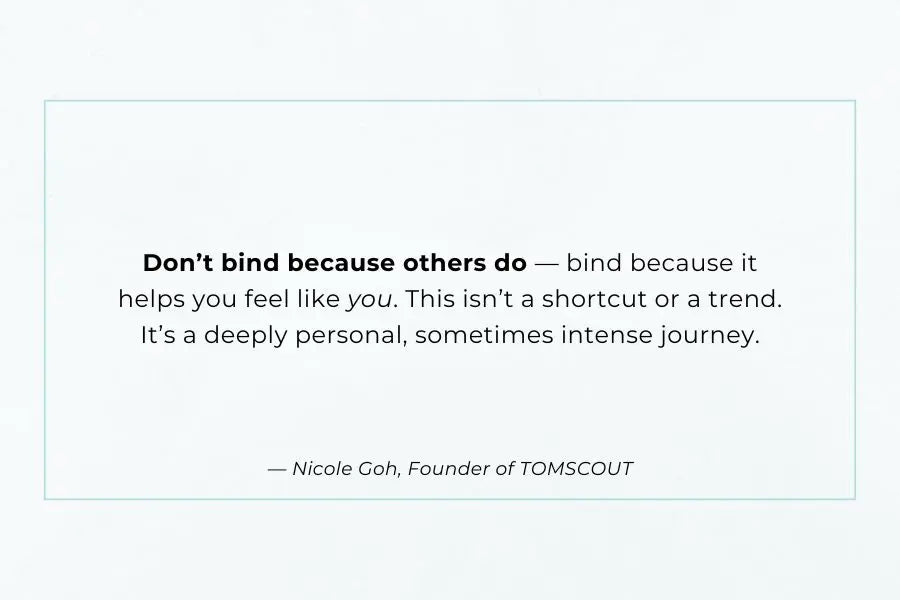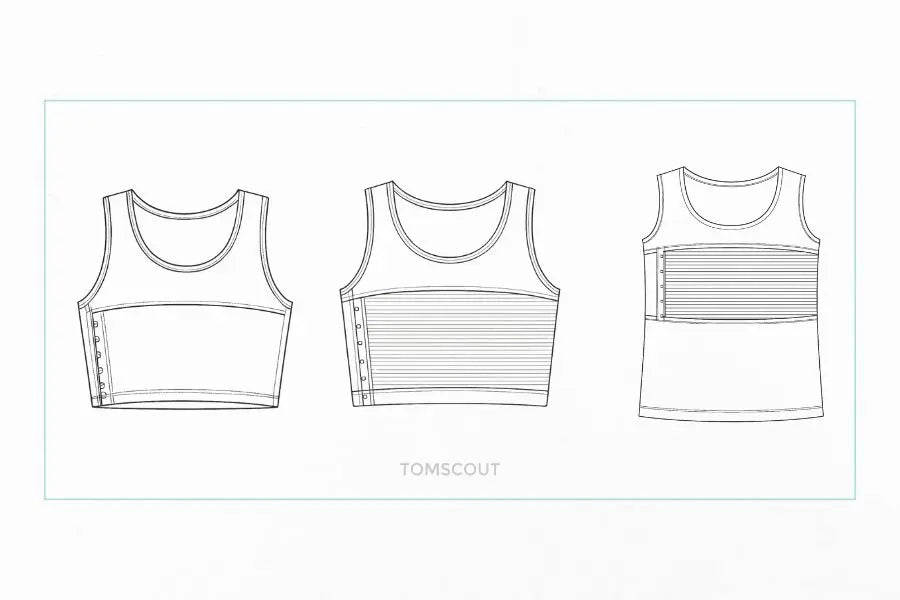Chest Binding 101: Your Safe, Affirming Guide to Feeling at Home
Finding comfort in your body is powerful — and chest binding can be a deeply affirming step on that journey.
Whether you're just starting out or exploring new questions, this guide offers safety tips, real support, and honest answers from our community and experts.
You deserve to bind safely, confidently, and on your own terms. Let’s begin — at your pace.
Explore This Guide
Here’s what you’ll find inside — how to bind safely, choose the right binder, avoid common mistakes, and shop with confidence as you get started.
What is Chest Binding?
Chest binding involves wearing a compression garment — known as a chest binder — to create a flatter chest appearance. It’s a daily practice for many trans men, non-binary individuals, and people across the gender spectrum who want their body to reflect how they truly see themselves.
Binding can ease gender dysphoria, reduce social anxiety, and help you feel more in control of how others perceive your body.
That first time binding can feel like a breath of relief — a moment when your reflection starts to match your identity. It’s not just about how you look — it’s about ease, expression, and the quiet power of reclaiming your sense of control.
When done safely, chest binding becomes more than a garment — it becomes part of your journey toward comfort, confidence, and self-respect. That’s why fit and support matter. If you’re wearing it for 10 hours a day, your body deserves more than “good enough.”
Is Chest Binding Safe?
Chest binding can absolutely be safe — as long as you’re using a well-made binder that fits your body and you’re giving yourself the care and breaks you need. It’s like anything you wear regularly: comfort, fit, and self-awareness matter.
The biggest risks usually come from using unsafe methods — like ACE bandages, duct tape, or binders that are too tight. These can restrict your breathing, hurt your ribs, or leave you feeling worse, not better. No one should have to trade safety for self-expression.
⚠️ If you have preexisting conditions like asthma or rib injuries, it’s a good idea to check in with a healthcare professional before binding regularly.
That’s why we care about real materials, good design, and sharing what we’ve learned — so you can bind with confidence, not fear. When you bind smart, you bind strong — and your body gets to move through the world with more ease, not less.
How to Choose the Right Binder
The right binder isn’t just about flattening — it’s about supporting your body, identity, and peace of mind throughout your day. A good binder should support you, not restrict you. Think movement, breathability, and comfort that lasts.
Look for binders made from high-stretch, breathable materials like nylon, spandex, or custom compression blends — fabrics chosen for airflow and a gentle yet firm hold.
Skip anything stiff, overly tight, or unstructured — your binder should move with you, not fight you.
Pay attention to your chest shape, activity level, and how long you’ll wear it each day. Some people prefer full-length binders for all-day wear, while others go for half-length or racerback styles for more flexibility.
The best binder is the one that feels like it was made for you. That’s why we offer flexible styles, inclusive sizing, and our Fit Quiz — to match you confidently, with no guesswork.
Binding Tips for First-Timers
Starting to bind can feel exciting, emotional, and even a bit overwhelming — and that’s okay. Your body is learning something new, and it deserves time and care as it adjusts.
- Start slow and ease in: For the first 2–4 weeks, wear your binder for no more than 6 hours/day. Some initial tightness is normal; remember, every body adapts at its own pace.
- Check your fit: It should feel snug but never painful. If you can’t take a full breath or feel restricted, it’s too tight.
- Stay aware of body heat: Some people feel warmer when binding — especially with layers or in hot weather. If that’s you, stay hydrated and take cooling breaks as needed.
- Don’t sleep in your binder: Always remove it before bed. Your chest and lungs need to rest and breathe.
- Listen to your body: If you feel sore, dizzy, or out of breath — pause, rest, and reassess fit and duration.
Binding should feel like support — not struggle. A gradual, respectful start protects your health and builds long-term comfort and confidence.
Free Chest Binding Checklist (Download)
Just starting out? Download our beginner‑friendly guide — expert‑backed, body‑respectful, and designed for first‑time binders who care about safety and fit.
Safety Guidelines & Signs of Trouble
Binding safely doesn’t mean holding yourself back — it means giving your body what it needs to move, breathe, and thrive while affirming your gender.
Keep these guidelines in mind to protect your health and make binding a sustainable, supportive part of your life:
- Ease in, then extend: During your first 1–2 months of binding, it’s best to limit wear to around 6–8 hours a day to give your body time to adjust.
Once you’re comfortable and confident in your binder, longer wear times can be totally safe — just keep listening to your body. - Never double-bind: Layering two binders or wearing a binder over a sports bra can create excessive pressure and rubbing that leads to discomfort or injury.
- Use the right binder for activity: If you plan to work out while binding, make sure you're using a high-stretch, breathable binder specifically designed for movement. Comfort and airflow are key.
⚠️ Signs to pay attention to:
- Shortness of breath
- Chest or back pain
- Skin irritation or bruising
- Dizziness or lightheadedness
If something feels off, don’t push through it. Your comfort and health are worth listening to — every single day.
Binder-Free Ways to Feel Affirmed
Binding is powerful — but it’s not the only way to feel affirmed. Whether it’s a day off or just a different kind of comfort, you deserve options that support your body, your identity, and your pace.
What matters most is feeling seen, valid, and at home in yourself — no matter what you wear.
- Softer support options: On lighter days, a comfy sports bra or looser tank can offer relief without pressure.
- Layer with intention: Oversized fits, structured fabrics, or darker tones can soften your shape without needing a binder.
- Style as affirmation: Haircuts, jewelry, posture, and voice — all subtle, powerful ways to affirm your identity.
There’s no one “right” way to feel affirmed. Your binder is a tool — not a rule.


Where to Buy a Binder
You deserve a binder that fits your body, supports your journey, and helps you move through the world with confidence. Whether you’re buying your first or upgrading to something better, the right binder can truly change how you feel in your clothes—and in yourself.
When choosing a binder, look for inclusive sizing, breathable fabrics, and designs that feel affirming. Read reviews, ask questions, and trust your instincts — your comfort is non-negotiable.
At TOMSCOUT, we craft binders that feel custom-designed for your body — because they are. Safe, comfortable, and made for real life, our binders let you show up with confidence every day — not compromise.
Frequently Asked Questions
If you're between sizes:
• Choose the larger size if you have broad shoulders or weigh above the range.
• Choose the smaller size if you’re slimmer or prefer a snug fit.
Each binder style has its own chart and real-customer examples — so you can choose with confidence.
👉 View the Chest Binder Size Guide
• Breathe deeply without effort
• Move freely without pinching or strain
• See no bulging, chafing, or deep red marks after removal
If it feels painful or restrictive, it’s not the right fit.
Always choose comfort over compression — your health isn’t negotiable.
Just use a well-fitting, breathable binder and keep checking in with your body.
If anything feels off — tightness, soreness, shortness of breath — take a break.
Look for high-stretch, breathable materials that flow with movement.
Avoid heavy-compression styles during intense exercise. If you feel overheated or short of breath, take it off and cool down.
Your movement should feel supported — not restricted.
A sports bra offers light compression for movement and comfort. A chest binder gives firmer, more even pressure across the chest, creating a flatter appearance — especially when gender expression is part of the goal.
The fit, materials, and intention are different — and that difference matters.
Hand-wash or use a laundry bag on cold, gentle cycle. Always air-dry flat — heat can damage compression and shorten lifespan.
Proper care protects both your health and your binder’s performance.
👉 Read our full Chest Binder Washing Guide
Still unsure? We’re here to help. Reach out anytime and we’ll guide you toward a safer, more comfortable fit that works for your body and goals.




